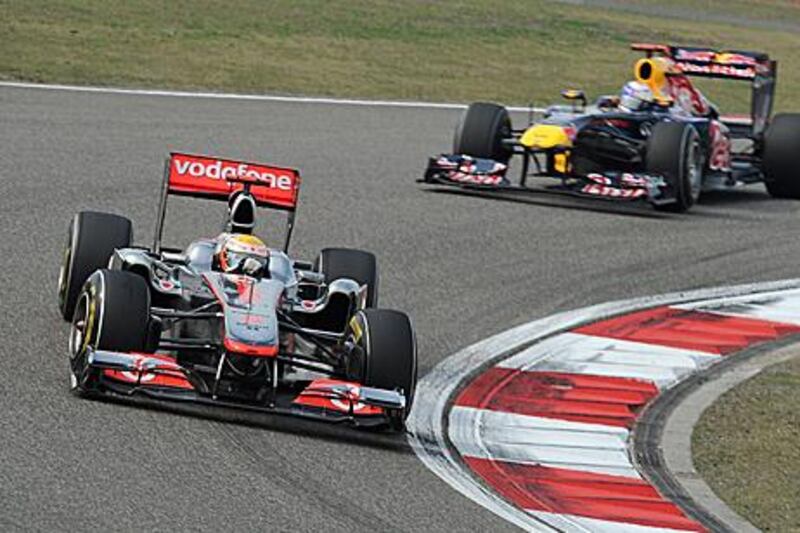Vettel can be stopped
Until the 52nd lap on Sunday, it seemed Sebastian Vettel and his Red Bull Racing RB7 were indomitable this season. After turning pole positions into comfortable wins in Australia and Malaysia, few expected anything but further domination at the Shanghai International Circuit. The destination of the 2011 world championship was quickly becoming all too inevitable.
However, courtesy of Lewis Hamilton's vintage driving and what he would later call a "smarter strategy," that is no longer the case.
The McLaren-Mercedes driver's manoeuvre to pass the reigning champion with four laps remaining was pivotal, precise and perfectly executed. Even Vettel, who was expecting an attack, admitted his surprise when it finally arrived; the 23-year-old German's tyre vulnerability aggressively exploited.
Hamilton's first grand prix win in eight months has blown the drivers' championship wide open, while also proving to rival teams what can be achieved in a short space of time with passion, dedication and, ultimately, resources.
Team Lotus are moving up
Sixteenth place is not Heikki Kovalainen's highest finish since joining Team Lotus, yet on Sunday he proclaimed it the team's "best ever performance".
The Finn, in beating Sauber's Sergio Perez and Williams' Pastor Maldonado, provided a positive indication that Tony Fernandes's team are closing the gap between themselves and the middle order.
Riad Asmat, the Team Lotus chief executive, said he was "lost for words" after watching his embryonic outfit race against such established teams, while Mike Gascoyne, the venerated chief technical officer, said it was their "strongest race in F1".
Lotus are developing quickly and Fernandes is not entirely unrealistic to suggest he can "smell points".
Pressure is on at Ferrari
Ferrari have expressed frustration and disappointment by their lacklustre start to the season. Fernando Alonso, who came within one defective decision of last year's world championship in Abu Dhabi, said before Sunday's race that the best he could realistically hope for was the bottom step on the podium.
He eventually finished in seventh place, behind teammate Felipe Massa.
It was the second time in as many races Alonso had been beaten by the Brazilian, who claimed it as his best race in more than a year.
The Spaniard inevitably blamed the pace of the car and said his two-stop strategy was irrelevant, but Massa said he would have finished higher had his game plan been different.
With three weeks until the Turkish Grand Prix, Ferrari's season hinges on how successfully the team can improve the car in Maranello. If they fail, heads will roll. Luca di Montezemolo, the Ferrari president, had demanded an "amazing reaction" going into the weekend, but was instead left angry.
"This cannot and must not be the team's level," he said.
Williams woes are ongoing
Rubens Barrichello and Maldonado may have finally finished a race this season, but the South Americans' performances did not provide the top-six finish for Williams that Barrichello had earlier said he believed was possible.
Venezuelan Maldonado finished 18th and veteran Barrichello crossed the finish line 13th, meaning that with three races complete, Sam Michael's team have yet to score a point.
Michael indicated afterwards that he was willing to step down if it would improve the team's fortunes. "What I would not be happy with doing would be not changing anything - even myself," he said.
Such measures are unlikely to take place before the next race in Turkey on May 8 as Williams are taking a major updates package to Istanbul in a bid to be competitive.
If that fails, however, the car may not be the only component facing an overhaul.
Rule changes are working
For the second week running, the new regulatory changes made in Formula One have provided spectators with engrossing entertainment - and it should be seen as no coincidence that both Shanghai and Sepang were designed by Hermann Tilke, the same architect who created Yas Marina Circuit.
Tilke's tracks are made for overtaking, but it is innovations such as Kers (Kinetic energy recovery system), the moveable rear wing and the new quick-wearing Pirelli tyres that have proved critical in making that possible.
No doubt Malaysia will be remembered more for its plethora of pit stops, but Shanghai will live long in the memory for the daring cut and thrust manoeuvres performed by drivers such as Mark Webber and Hamilton.
"I appreciate the new regulations are complicated," said Martin Whitmarsh, Hamilton's team principal at McLaren.
"But for the past two races now, at circuits where traditionally when it has been dry they have not created genuine races, nobody has been able to go away complaining."





